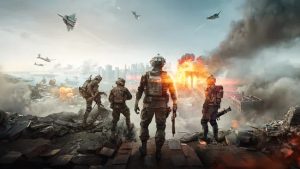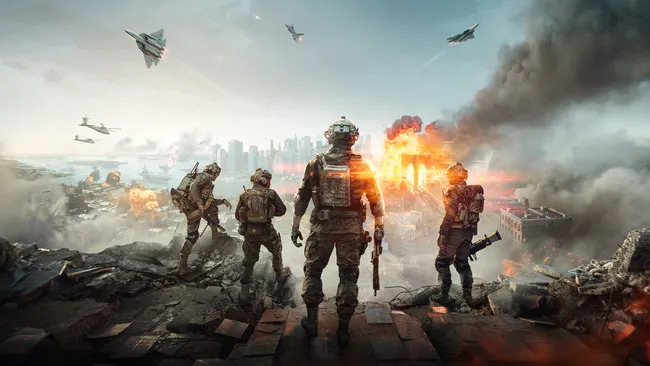The multiplayer action in Battlefield 6 revolves around layers. There is the infantry layer, where groups of soldiers engage in foot-to-foot combat; the land vehicle layer, where tanks and armored vehicles reshape the front lines with formidable weapons that can destroy infantry and bring entire buildings to the ground; and the sky layer, where a few flyers control the air and can destroy ground forces. In addition to being incredibly unique, each layer is also incredibly well-made, and they all seem to blend harmoniously.
Although it takes a bit too long to obtain the better equipment that makes your loadouts really fascinating, and some of the levels have a terrible habit of turning into sniper-infested hellscapes, those are small complaints about what is otherwise one of the best multiplayer shooters of the year. Great moment-to-moment gunplay is the foundation of the entire game, with the majority of the battle taking place between general infantry.
The sound and appearance of weapons are amazing, especially if you have a powerful sound system or headphones to hear the loud booms and minute details like bullet casings dropping to the ground. Although most guns have a small amount of recoil and bullet spread, you don’t need to be an experienced shooter to be able to make shots. Guns are accurate, but they also account for bullet travel and drop just enough to reward excellent shooting.
Despite having somewhat different identities, the four classes available are generally well-balanced. It’s a lot of fun to run and shoot as the Assault Class, but it’s as satisfying to switch gears and concentrate on keeping your comrades alive as a Medic. Even if you decide to be less involved in the actual combat, you can still help turn an attrition match by using your defibrillator to preserve your team’s collective life supply from running low while also putting one of your fighters back into the action. It’s excellent for guaranteeing that everyone can participate by effectively fulfilling their function.
Nevertheless, I’m not really sure how I feel about the way the loadouts are put together. Although I value the freedom to equip any class with any weapon, I can’t help but want to just load up every class with my favorite assault rifle and call it a day. Although each class has a bonus effect for utilizing the weapons that are typically associated with it, such as the Recon class’s increased accuracy and higher rate of fire when using snipers, these bonuses are so minor that I soon found myself ignoring them. That’s not to argue that courses are irrelevant—for instance, to fix tanks, you still need to be an engineer—but I find the distinctions to be a bit too hazy.
A match can be won or lost by a competent tank commander.
The length of time it takes to unlock items in between bouts is the other problem. To unlock the majority of weapon and equipment options, you must either finish multi-tiered tasks or achieve specific levels. The level requirements are too high, but that’s all well and good, and a regular schedule of daily and weekly tasks keeps level-ups from being a tedious chore. Until you reach level 20, which could take dozens of hours, you cannot even begin working on the class-specific challenges that are required to gain various sub-class-like training routes.
It regrettably delays the early experience before finally finding its rhythm because really potent equipment options, such as the Deploy Beacon, which serves as your squad’s remote spawn place, are locked behind that. The involvement of automobiles is the next step forward; although they are limited to larger maps, their arrival causes chaos in the greatest possible way. Control and pandemonium are equally created when a tank rolls along the street. Their ability to scatter the enemies as their machine guns and cannon erupt makes them the center of attention in any battle. Buildings also become the most crucial target to clear when they blow up, and rubble falls from them.
The way vehicles reverse strategic calculus is quite good for keeping matches exciting, whether that means calling in your own tank, moving to the Engineer class after being taken out so you can launch rockets, or doing something else entirely. I also like that tanks take more expertise than fighting on foot, even though they aren’t particularly difficult to use. A competent tank commander can make or break a match if they know when to employ defensive countermeasures or when to advance to capture territory instead of retreating and allowing allied engineers to fix them.
Being somewhat of an aviation geek, I have a thing for the last layer, which is the skies. I enjoy boarding a plane, winning dogfights, strafing opposing teams, and, just for fun, incorporating some bombing runs. Helicopters and airplanes make it exciting to fly, terrifying to be below, and incredibly satisfying to shoot someone down with a well-placed rocket while walking. They need the highest level of competence, requiring you to become proficient with a sophisticated set of controls and possess a more sophisticated grasp of aircraft operation to make the most of them. In theory, I don’t mind, but it’s very hard for beginners to learn to fly because there isn’t a suitable way to practice or train those skills.
Battlefield modes are back, and they’re still as entertaining as ever. The 64-player battles of Breakthrough and Conquest are still the highlights because of their incredibly large scope; while Team Deathmatch is a good warmup, the latter pits two teams against an infinite number of defenders for control of a shared area, while the former asks one team with limited lives to advance the frontline and capture points. Their ability to focus the action on particular regions is still excellent, allowing for large-scale conflicts to take place in the streets and the sky while close-quarters skirmishes take place on the objectives.
Although some have been overrun by snipers, the maps are generally robust.
Other options include Rush, a CounterStrike-like mode geared toward smaller groups. Rush quickly became one of my favorites because of its rapid action and brief duration, which makes it a fantastic substitute for longer tug-of-war sessions during shorter sessions. Additionally impressive is the recently added Escalation mode, which forces increasingly fierce combat as you get closer to the conclusion by having you fight over a vast number of control points that gradually diminish. Because the battlefield’s shifting shape requires a pleasant change in tactics throughout, I really enjoy that.
From the congested streets of Saints Quarter, which is ideal for action in close quarters, to the massive, vehicle-filled Operation Firestorm, nine maps at launch are typically strong. One of my faves is Empire State since it has a nice mix of open spaces with highways, buildings to hide in, and rooftops to shoot from. Learning the maps gives you a tactical edge, and the fact that you may capture a building’s rooftop across from an objective point to eliminate an enemy team from above highlights how strategic Battlefield 6’s combat is.
However, not all maps are immediately successful. Because one hill is constantly populated by snipers, Liberation Peak has already earned a reputation as a well-deserved meme in the community. This detracts significantly from the class balance that Battlefield depends on. Mirak Valley is quite comparable, especially in Breakthrough games, where the attackers are up against a group of sharpshooters with limited cover. Furthermore, although I think New Sobek City is a great place overall because of its diverse terrain and cheerfully destructible buildings that make it stand out, it may also get so overrun with anti-vehicle mines that tanks are rendered useless.
It detracts from what is normally a top-tier location for combat; however, it may be more of a problem with the balance of the mines themselves because they have a propensity to grow much too many very soon.
The fact that all of the maps look fantastic is really helpful, especially when you consider how outstanding their destructibility is. Bullets strike structures, and chunks of cement fall. Buses and cars blow up, and a well-placed grenade launcher shot can quickly eliminate cover. In addition to altering the terrain in meaningful ways that are never the same from match to match, you can use a tank to bring down entire buildings, which is terrible to be on the wrong side of.
The way everything works together, including the stages, the destruction, and the fighting, is what’s most amazing. At one point, I was engaged in a fierce struggle for control of a section of the New Sobek City construction sites. Until I rode my tank in and smashed through a wall and several support columns, the enemy was well entrenched. I sprayed ammunition from my machine gun, ignoring the dust and debris that coated everything, while my teammates cleaned up the remainder. It was stunning, and no other game offers anything like it on this scale.
Verdict
Battlefield 6’s multiplayer gameplay is expertly built, covered in a wonderful layer of destructibility that both looks great and tangibly influences the flow of combat. With weapons that are accurate enough to reward skillful shooting and have just enough sway to encourage a little deliberate thought while aiming, the gunplay is superb. The majority of the options play fairly well overall, though I wish the early progression didn’t completely ruin the pleasure of loadout creation, and some of the maps could use some tuning. Furthermore, those are small complaints about an overall fantastic experience. This one is as accurate as a shot with my reliable M2010 sniper rifle.

